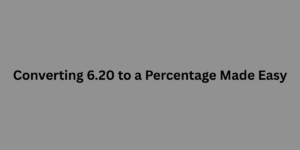Have you ever come across a number like 6.20 and wondered how to express it as a percentage? Whether you’re dealing with schoolwork, financial data, or business metrics, understanding how to convert decimals to percentages is a valuable skill.
In this guide, we’ll break down how to Converting 6.20 to a Percentage , explore why this conversion is useful in real life, and provide practical tips to help you master similar conversions. With clear explanations, examples, and a step-by-step approach, this article will simplify the math and boost your confidence.
What Is a Percentage?
Before diving into conversions, let’s get back to basics.
A percentage is a number or ratio expressed as a fraction of 100. The symbol % literally means “per hundred.” So when you say 50%, you’re saying “50 out of 100.”
Real-World Relevance:
Percentages are used in:
- Shopping discounts (e.g., 30% off)
- Interest rates (e.g., 5.5% APR)
- Grades and exams (e.g., 92% score)
- Data analysis and statistics
Decimal to Percentage Conversion: The Simple Rule
To convert any decimal to a percentage, simply multiply the decimal by 100 and add the percent symbol (%).
The Formula:
Step-by-Step: Converting 6.20 to a Percentage
-
Start with the decimal: 6.20
-
Multiply by 100:
6.20 × 100 = 620 -
Add the % symbol:
Final answer = 620%
✅ Result: 6.20 = 620%
Why Is 6.20 Equal to 620%?
It might seem surprising that 6.20 equals 620%, especially when we’re used to percentages being under 100%. But remember:
- 1.0 = 100%
- 2.0 = 200%
- So, 6.20 = 620%
This just means that 6.20 is 6.2 times the whole, or 620 out of 100.
Real-Life Applications of 620%
Understanding 620% might sound theoretical, but it actually pops up in various real-world scenarios.
1. Business Growth Metrics
If a company increased revenue from $1,000 to $7,200, the growth is:
- Change = $7,200 – $1,000 = $6,200
- Growth = $6,200 ÷ $1,000 = 6.20 → 620%
2. Investment Returns
If you invested $500 and now it’s worth $3,600:
- $3,600 ÷ $500 = 7.20
- Return = 7.20 – 1 = 6.20 → 620% return
3. Price Markups
If a product costs $10 to make and sells for $72:
- $72 ÷ $10 = 7.20 → Markup = 620%
Common Questions About Percentage Conversions
❓ Can a percentage be over 100%?
Yes! A percentage over 100% means the value is more than the whole. For instance:
- 200% = twice as much
- 620% = 6.2 times as much
❓ How do I convert other decimals?
Use the same formula:
- 0.75 × 100 = 75%
- 1.25 × 100 = 125%
- 3.5 × 100 = 350%
❓ What is 620% as a decimal?
Reverse the formula:
- 620% ÷ 100 = 6.20
Quick Reference Table: Decimal to Percentage
| Decimal | Percentage |
|---|---|
| 0.50 | 50% |
| 1.00 | 100% |
| 2.50 | 250% |
| 6.20 | 620% |
| 10.00 | 1000% |
Tips for Easy Percentage Conversions
- Memorize key benchmarks: 0.5 = 50%, 1 = 100%, 2 = 200%
- Use a calculator for speed
- Double-check your work with reverse math: Percentage ÷ 100 = Decimal
Useful Tools and Resources
- Online Percentage Calculators
Try tools like Calculator Soup or Rapid Tables for instant conversions. - Math Learning Platforms
Platforms like Khan Academy offer free lessons on decimals, fractions, and percentages. - Spreadsheet Software (Excel, Google Sheets)
Use formulas like=6.20*100 & "%"for quick conversion in Excel.
Suggested Visual: Infographic
A helpful infographic can make this even easier to understand. Here’s what to include:
- A flowchart showing the steps:
Decimal → Multiply by 100 → Add % - A comparison scale:
0.5 = 50% → 1 = 100% → 6.20 = 620% - A real-world example breakdown (business profit, investment return)
Alt Text for Image: “Step-by-step visual showing how to convert 6.20 to 620% with examples.”
Conclusion: Master Percentage Conversions with Ease
Now that you know how to convert 6.20 to a percentage, you’re better equipped to tackle similar math problems with ease. Remember, the process is simple: multiply by 100 and add the percent sign.
From business analytics to budgeting, understanding percentages gives you a valuable edge. Keep practicing, use the tools we’ve suggested, and you’ll be a percentage pro in no time.
Got a tricky decimal you want to convert? Drop it in the comments below or explore our other math tutorials for more helpful guides!


